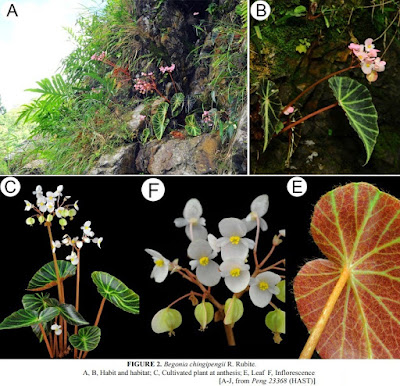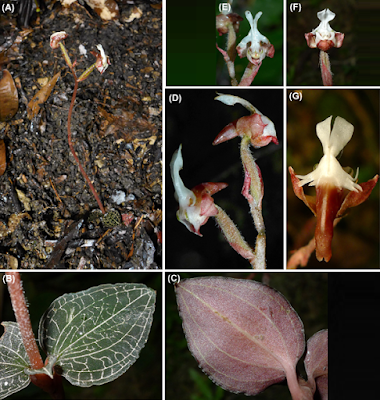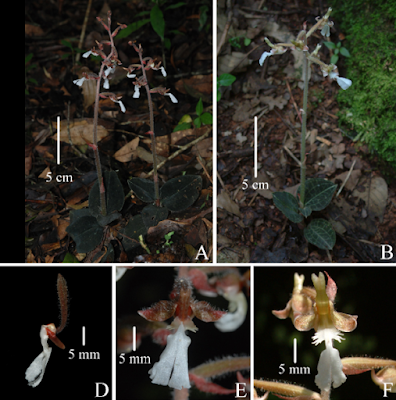[Most Recent Entries] [Calendar View]
Sunday, July 17th, 2016
| Time | Event | ||||
| 9:57a | [Botany • 2014] Begonia chingipengii • A New Species (sect. Baryandra, Begoniaceae) from Luzon Island, Philippines
Abstract Begonia chingipengii from Gabaldon, Nueva Ecija, Luzon Island is described as a new species endemic to the Philippines. This is the latest addition to the newly delimited Begonia section Baryandra. It resembles Begonia trichochila but is distinguished by the variegated leaves with light green veins and midrib contrasting with the dark green adaxial surface and maroon abaxial surface, and its oblique leaf is elongated with an acuminate apex. The robust variegated leaves, large flowers and extensive inflorescence make it very attractive. Keywords: Begoniaceae, Baryandra, Begonia chingipengii Ecology :— Disturbed broadleaf forest; on rocky slope above stream. PHILIPPINES. Luzon Island. Nueva Ecija Etymology :— The plant is named in honor of Dr. Ching-I Peng, the leader of the expedition, collaborator, mentor and supporter of R. R. Rubite in the studies of Philippine begonias.
Discussion Like a number of other species of Begonia in the Philippines (e.g. B. blancii and B. suborbiculata, Hughes et al. 2011) and some species in southern China [e.g. B. leprosa Hance (1883: 202), Peng et al. 2010; B. peltatifolia H. L. Li (1944: 209) and B. pseudodryadis C. Y. Wu (1995: 276), Peng, unpublished data], the clustered stomata of B. chingipengii (Figure 4B) and B. trichochila (Figure 4E) are likely to be a way in which the species copes with periodical drought or fluctuating environment (see discussion in Gan et al. 2010; Hughes et al. 2011). In the area where B. chingipengii was collected, only two small populations were seen. The following day the expedition group progress farther but failed to find any other population. This is the nature of Philippine begonias—they tend to be very narrowly endemic, characterized by small populations and are often confined to a particular locality. Rosario Rivera Rubite, John Rey Callado, Yoshiko Kono and Hsun-An Yang. 2014. Begonia chingipengii (sect. Baryandra, Begoniaceae), A New Species from Luzon Island, Philippines. Phytotaxa. 164 (3): 175–182. DOI 10.11646/phytotaxa.164.3.2 ResearchGate.net/publication/283142019_Begonia_chingipengii_sect_Baryandra_Begoniaceae_a_new_species_from_Luzon_Is | ||||
| 1:15p | [Botany • 2013] Begonia jamilahana • A Remarkable New Species of Begonia sect. Petermannia (Begoniaceae) from Brunei Darussalam [Novitates Bruneienses, 2]
ABSTRACT Begonia jamilahana Y.W.Low, Joffre & Ariffin is described and illustrated here as a new species based on a collection from Ladan Hills Forest Reserve, Tutong, Brunei Darussalam. This new taxon is closely related to B. conniegeriae S.Julia & Kiew and B. papyraptera Sands, but differs in a suite of morphological characters. Begonia jamilahana is placed in Begonia section Petermannia, the largest of all the sections recognised. Keywords. Begonia jamilahana, Begoniaceae, Borneo Begonia jamilahana Y.W.Low, Joffre & Ariffin, sp. nov. (sect. Petermannia) Similar to Begonia papyraptera Sands but differs in having a smooth and terete stem, leaf blade scantily covered with translucent hispid hairs on both sides, upper mature leaf surface dark green with red markings on vein axil nodes nearer to the base of the leaf, lower leaf surface pale green, and base of capsule wings cuneate. TYPE: Brunei, Tutong District, Lamunin, Ladan Hills Forest Reserve, Compartment 1, 58 m, 4°42’16”N 114°44’12”E, lowland mixed dipterocarp forest on yellow sandy clay soils, steep slope, 15 Dec 2010, P. Azlan, A.K. Muhd. Ariffin, A. Watu & M. Rauzaidi BRUN 23373 (holotype BRUN (including spirit material); isotypes K, SING). (Fig. 1, 2) Distribution and habitat. Begonia jamilahana is so far known only from the Ladan Hills Forest Reserve, where it was documented on steep earth banks and adjacent slopes in the mixed dipterocarp forest on yellow sandy clay soils. Etymology. This species is named for Hajah Jamilah binti Haji Abdul Jalil, acting Deputy Director of the Brunei Forestry Department, upon her retirement in 2015, as a token of appreciation for her excellent service rendered to the Forestry Department, as well as her unwavering support for the Brunei-Singapore botanical exploration programme. Y.W. Low, A.A. Joffre and A.K. Muhammad Ariffin. 2013. Novitates Bruneienses, 2. A Remarkable New Species of Begonia sect. Petermannia (Begoniaceae) from Brunei Darussalam. Gardens’ Bulletin Singapore. 67(1): 61–68. DOI: 10.3850/S2382581215000071 | ||||
| 2:43p | [Botany • 2015] Anoectochilus nandanensis • A New Orchid Species (Orchidaceae) from northern Guangxi, China
Anoectochilus nandanensis, a new species from northern Guangxi, China, is described and illustrated. It is similar to A. emeiensis K. Y. Lang in habit, but distinguished by the size of the plant, leaves and lateral sepals, as well as the flanges of the mesochile. Xin-Cheng Qu, Yun-Feng Huang, Hui-Zhe Feng and Ren-Chuan Hu. 2015. Anoectochilus nandanensis sp. nov. (Orchidaceae) from northern Guangxi, China. Nordic Journal of Botany. 33(5); 572–575. DOI: 10.1111/njb.00847 | ||||
| 4:04p | [Botany • 2014] Anoectochilus longilobus • A New Species (Orchidoideae: Orchidaceae) from Yunnan, China
Abstract Anoectochilus Blume (1825: 411; Orchidaceae) belongs to subtribe Goodyerinae (Cranichideae; Orchidoideae; Pridgeon et al. 2003). The generic name is derived from the Greek words ‘anoiktos’ (open) and ‘cheilos’ (lip), referring to the flower with prominent lip giving an open appearance (Sumathi et al. 2003, Bhattacharjee 2013). The genus consists of about 30 species according to Genera orchidacearum (Pridgeon et al. 2003), distributed in India and the eastern Himalayas, through southern and southeastern Asia to Australia and the southeastern Pacific islands (Chen et al. 2009). There are 15 species of Anoectochilus in China, eight of which were reported from Yunnan previously (Chen et al. 2009, Chen & Shui 2010, Hu et al. 2012, Ormerod 2013). A species of Anoectochilus was collected in Yunnan by the authors in 2006 and 2013. On the basis of careful examination and comparison with closely related species (Seidenfaden 1971, 1978, Seidenfaden & Wood 1992, Lang 1999, Averyanov 2008, Chen et al. 2009), it has been confirmed as an undescribed species. This new species is similar to A. zhejiangensis Wei & Chang (1989: 39), which is endemic to China and distributed in central and northern Fujian, northern Guangxi, southwestern Zhejiang (Chen et al. 2009) and northern Guangdong (Tian et al. 2013); it is also close to A. chapaensis Gagnepain (1931: 679), which is distributed in China and Vietnam (Chen et al. 2009). Anoectochilus longilobus H.Jiang & H.Z.Tian, sp. nov. (Figs. 1, 2A, B, D–F and H–L) Anoectochilus longilobus is similar to A. zhejiangensi and A. chapaensis, but differs from the former in having much bigger leaves and flowers and a straight spur with an acute angle between lip and from the later in having a cylindrical spur; it is distinguished from both by having longer, obliquely ligulate obcuneate, truncate epichile lobes. Type:—CHINA. Yunnan: Malipo, Mt. Laojun 1550 m, in forests, 28 July 2006, Jiang 04240 (holotype KUN!) Huaizhen Tian, Qiao-Xia Liu, Cheng Zhiquan, Ai-Qun Hu and Hong Jiang. 2014. Anoectochilus longilobus (Orchidoideae: Orchidaceae), A New Species from Yunnan, China. Phytotaxa. 164(4): 276-280. DOI: 10.11646/phytotaxa.164.4.6 |
| << Previous Day |
2016/07/17 [Calendar] |
Next Day >> |







